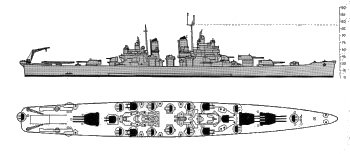![]() The Pacific War Online Encyclopedia
The Pacific War Online Encyclopedia
|
| Previous: Balloon Bombs | Table of Contents | Next: Ban Masami |
 ONI 222 |
| Tonnage | 14,472 tons standad displacement |
| Dimensions | 673'6" by 70'11" by 26'11" 205.26m by 21.59m by 7.32m |
| Maximum speed | 33 knots |
| Complement | 2039 |
| Aircraft | 2 catapults 4 seaplanes |
| Armament | 3x3 8"/55
guns 6x2 5"/38 dual-purpose guns 11x4, 2x2 40mm Bofors AA guns 28 20mm Oerlikon AA guns |
| Protection | 1790 tons 6" (152mm) machinery belt tapering to 3" (76mm) backed by 0.625" (16mm) STS steel 6" (152mm) machinery bulkheads 3" (76mm) magazine belts tapering to 2" (51m) 5.5" (140mm) forward magazine bulkhead 5" (127mm) aft magazine bulkhead 2.5" (65mm) armored deck 6.3" (160mm) barbettes 8"/3"/3.75"/1.5" (203mm/76mm/95mm/38mm) turret face/roof/side/rear 1"/0.75" (25mm/19mm) secondary battery turret face/sides and roof 6"/3" (152mm/76mm) conning towers sides/roof |
| Immune zone |
12000 to 24000 yards (11000m to 22000m) against 8" shells 1000lb (454 kg) bombs to 10,000' (3000m) |
| Machinery |
4-shaft General Electric geared
turbines (120,000 shp) 4 Babcock & Wilcox boilers |
| Bunkerage | 2243 tons fuel oil 26.8 tons aviation gasoline |
| Range | 7900 nautical miles (12,700 km) at 15 knots |
| Sensors |
SG surface search radar SK air search radar Mark 8 fire control radar Mark 12/22 fire control radar (2 sets) |
The Baltimores
were completed in 1943-45. A
development of the singular Wichita,
work on the design began in September 1939. The ships were designed to
remedy
the stability problems and cramped layout of Wichita
while retaining her protective scheme, and the turret arrangement was to
be based on Cleveland. A powerful secondary
battery of 5"/38 dual-purpose guns was also specified. The final design
deviated considerably from Wichita,
extending the hull by 65' (19.8m) and the beam by 9' (2.7m). Much of
the increase in weight over Wichita
went into strengthening the hull rather than increasing the protection.
The machinery was the same high-pressure design adopted for the Clevelands, but the cruising
turbines were abandoned in the later construction and removed from the
first units.
They were the definitive wartime American heavy cruiser class, well-protected and well-armed, particularly in their antiaircraft battery, and with good subdivision. This was in spite of the fact that their design originated under the treaty restrictions and there was little time to take advantage of the lapse of the treaties in the rush of naval construction just before and during the war. No foreign navy's heavy cruisers came close to matching them. They were almost as capable as the German Panzerschiffe (pocket battleships). The ships were intended as the middle class of a three-class system of cruisers, with the Clevelands forming the lightweight class and the Alaskas forming the heavyweight class.
The U.S. Navy was never happy about the slow rate of fire of 8" guns relative to 6" guns, which was one reason light cruisers continued to be built in large numbers. The loading angle on the Baltimores was brought as close as practical to the likely firing angle, the elevation speed was improved to ten degrees per second, and separate hoists were provided for each gun, but the gun cycle could not be reduced in practice to below about 13 seconds.
All the ships were fitted with CICs, but
there was some uncertainty where these should be located. They initially
replaced the navigator's sea cabin and chart house, then were placed on
the main deck, and finally were placed within the citadel on Pittsburgh and later units.
Though the ships could carry four seaplanes, the
hangar only had capacity for two seaplanes.
None of the ships ever saw surface
combat. They were
used primarily as escorts for carrier
task forces, having an antiaircraft battery second only to the fast battleships. None were lost and only Canberra suffered significant battle damage, from an aircraft torpedo.
They were quite expensive ships at $40 million apiece.
| Baltimore | arrived 1943-10 |
| Boston | arrived 1943-12-1 |
| Canberra | arrived 1944-1-20 |
| Pittsburgh | arrived 1945-1-20 |
| Quincy | arrived 1945-3-10 |
| Chicago | arrived 1945-5-15 |
| Saint Paul | arrived 1945-5-25 |
 |
 |
 |
 |
 |
 |
 |
 |
 |  |
 |
 |
References
Globalsecurity.org (accessed 2014-12-13)
Gogin (2010; accessed 2012-12-7)
The Pacific War Online Encyclopedia © 2007, 2009, 2012, 2014 by Kent G. Budge. Index